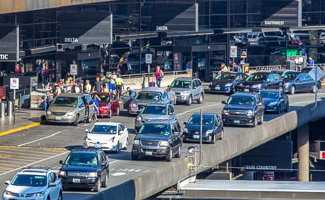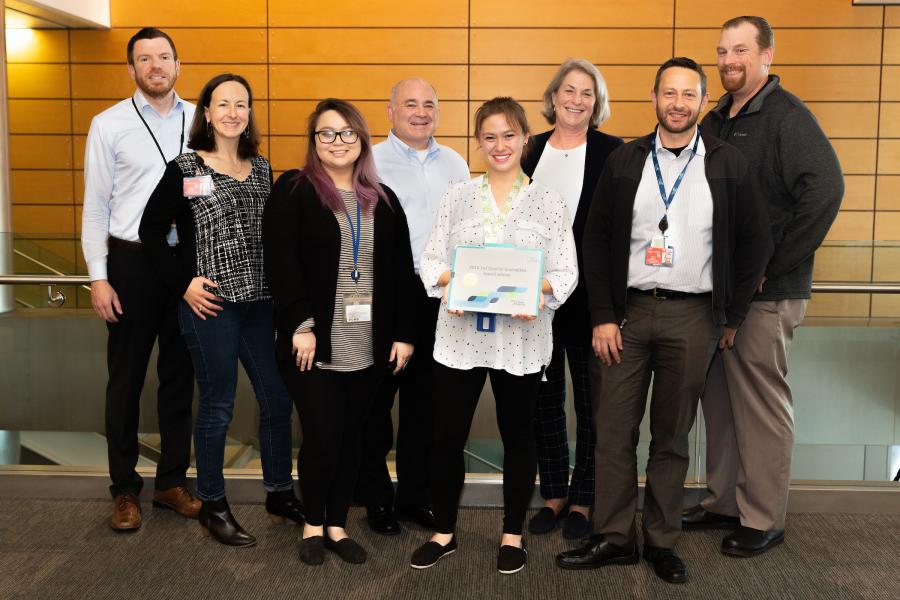 Sea-Tac Airport’s current roadway system was designed 50 years ago in 1968, when our annual passenger volume was about 5 million, a tenth of the 50 million annual passengers Sea-Tac welcomes today. Whatever people may have thought back then about what the future of personal transportation might hold—flying vehicles, teleportation—many passengers today still come by car, whether that means driving themselves, being picked up or dropped off by a friend, or taking a taxi or rideshare. At peak hours, over 1,700 cars, trucks, and buses per hour pack onto the airport drives on their way to arrivals, departures, or the parking garage. Cars merge and weave around each other in a hair-raising dance trying to get to just the right spot along the curb—and then do it again on their way out. On average, stop-and-go conditions persist about 4 hours per day.
Sea-Tac Airport’s current roadway system was designed 50 years ago in 1968, when our annual passenger volume was about 5 million, a tenth of the 50 million annual passengers Sea-Tac welcomes today. Whatever people may have thought back then about what the future of personal transportation might hold—flying vehicles, teleportation—many passengers today still come by car, whether that means driving themselves, being picked up or dropped off by a friend, or taking a taxi or rideshare. At peak hours, over 1,700 cars, trucks, and buses per hour pack onto the airport drives on their way to arrivals, departures, or the parking garage. Cars merge and weave around each other in a hair-raising dance trying to get to just the right spot along the curb—and then do it again on their way out. On average, stop-and-go conditions persist about 4 hours per day.
In Spring 2018, 21 Port professionals and outside stakeholders were selected to participate in a process improvement “LIFT” to tackle the challenge of congestion. A LIFT (Learning and Improvement through Focused Transformation) event is designed to immerse teams in focused problem solving using Lean/Continuous Process Improvement (CPI) methods and tools. While the Port is no stranger to Lean principles, this project was the first formal LIFT event ever held at the Port. It brought a wide variety of people together in a very condensed period of time to bring about rapid results.
The project group divided themselves into three teams focused on different aspects of traffic flow, including personal vehicles, buses, taxis and Transportation Network Companies (TNCs) like Lyft and Uber. Over the course of more than ten days of intensive sessions, the teams went through the process of training on LIFT, Lean fundamentals, and principles of problem solving. They studied and mapped existing traffic conditions, as well as a desired future state. Then they came up with a plan. The following table is just a snapshot of some of the problems they discovered and solutions they pursued:
|
Traffic Culprits |
Solution |
Impact |
|
Early morning peak period drop offs by taxis, TNCs, and other commercial transport vehicles causing stop and go traffic on the Departures drive. |
Signs advising taxis and TNCs to drop passengers off at arrivals instead of departures. Port Police vehicles with their lights on were also strategically placed by the signs to draw attention. |
52% reduction in stop and go conditions! |
|
A bottleneck by the Alaska Airlines curb, which is the first airline on the drive and constitutes about 50% of our traffic. |
Two Police Traffic Support Specialists were deployed at the Alaska curb to keep drivers from bunching up at the beginning and maximize use of the space available. |
Doubled the utilization of Lane 1, the lane directly adjacent to the curb, freeing up more space in the outer lanes and improving traffic flow. |
|
TNCs having to park to pick up and then back out of spots to leave |
Restriping the parking spots away from the curbs to allow cars to pull through as they leave |
25% improvement in pick up time, and 15.5% more pickups accommodated. |
Much more work lies ahead in solving the problem of traffic at Sea-Tac, especially as passenger use is only expected to grow more and more. The Traffic LIFT project not only produced solid improvements for our customers, but also built the Port’s capacity to solve other complex problems. The participants gained experience in how to collaborate, gather relevant data, identify root causes, and develop real, measureable solutions. Congratulations to the Traffic LIFT team for winning the 2018 3rd Quarter Innovative Idea Award.
Team Members

From the Port:
- Michael Ehl
- Jeff Hoevet
- Stacy Mattson
- Geraldine Poor
- Jeff Wolf
- Vicky Ausbun
- Sue Adams
- Nic Longo
- Thomas Hooper
- Crissa Adams
- Heather Karch
- Jerred Jones
- Nick Terrana
- Mandela Thomas
- Barbara Hummel
- Rosa Johnson
- Doug Pessemier
- Jim Witzman
External Partners:
- Will Appleton, City of SeaTac
- Ben Sacks, Lyft
- Arash Emami-Yeganeh, SP Plus
- Raj Bal, Limo
- Alexis Maxwell, Uber
- Jon Pascal, Transportation Consultant (Transpo Group)
- Alan Parsley, Consultant
- Sinha, Rina, Consultant
Honorable Mention for Stakeholder Collaboration
Aira: Sight Impaired Assistance: Free Service at Sea-Tac
Aira is a new augmented reality technology that gives independence to those that are sight impaired. The user subscribes to a monthly service that provides them a pair of glasses that includes an embedded camera. When the user needs visual assistance they trigger support through their phone. An operator on the other end can literally see what the user is looking at.
“Using augmented reality, Aira connects people who are blind or low vision to a trained professional agent who is dedicated to further enhancing their everyday experience—completely hands-free assistance at the touch of a button.”
Team Members:
- Pennie Saum
- Heather Karch
- Tim Jayne, (retired)
- Dave Wilson
Additional Nominated Projects
Using Technology To Prevent Injuries And Comply With Safety Regulations
Responding to employee feedback, the Port’s Health and Safety Team implemented use of the Origami Mobile Forms application. Employees could now report near misses and safety hazards immediately and directly on site from their phones without having to wait until they returned to an office or had access to a computer. Use of the app, along with many other safety reporting innovations since 2014, has significantly increased reporting and helped reduce injuries.
Team Members: Britney Gallagher, Tiffany Olson, Juan Martel, Tim Mitchel, and Dave Epstein
Online Aviation Division Key Request System
Replacing a paper form to request keys to restricted access locations with an online form cut the time it took to receive keys from 11 days to 7 days, and reduced request rejections due to improper information from 25% to 10%.
Team Members: Beth Britz, Aryn Schunzel, Rosa Johnson, Dan Zenk, and Christian Samlaska
AV Maintenance Fleet Key Storage
The fleet mechanic shop of Aviation Maintenance has found their vehicle fleet continuing to grow. Not only do they have more keys, but the newer keys are larger and many have key fobs. Inspiration for a newer, cleaner, and expandable key storage system came from a Carpenter Crew Chief, Ross Gumke, and his father, who was having issues with a “cabinet slide” on his RV. Recycling existing materials on hand, AV Maintenance staff built a similar system of compact sliding cabinets to securely store all of their keys in one place.
Team Members: Ross Gumke, Jeff Sorenson, John Reda, Benny Austin, Al Lazo, Ken McKenzie
Baggage System Engineer Weekly Top 3 Report
Baggage System Engineers and Baggage Operations Systems Specialists on the frontlines of the baggage handling system have been producing a new weekly report to identify and reduce “jams” and other inefficiencies in the system.
Team Members: Angie Schmitke, Ryan Pazaruski, John Street, Jerry Price, Phil Allan
Tenant Expense Review
The Aviation Project Management Group developed a standardized Tenant Improvement Project Concept Review process and template that quickly identified in one document the types of work that would and, perhaps more importantly, would not be involved in a proposed tenant construction project. Since implementing the new process: concept reviews are 3-5 days faster, duplicate review comments have been reduced by over 80%, the unintentional omission of key reviewers has been all but eliminated, and the number of tenant projects needing to be terminated after being approved has been reduced to zero.
Team Members: Alan Olson, Lana Rendel, Jason Johnson
3D Printing ITB Tamper Switch
The current brand of Interface Termination Box (ITB) that the Port uses did not come with pre-fitted tamper switches. Without a tamper switch, Aviation Maintenance staff would have no indication the ITB was opened or tampered with—a security risk. Staff could have purchased the tamper switch package separately for $40 each but it would have required going through and only taking the bracket out of the package—the rest was of no use. Instead, staff used a 3D printer to produce them for $.03 each. 500 brackets will be printed for the International Arrivals Facility and NorthStar projects, saving almost $20,000.
Team members: Teri Grosvenor, Navtej Sahota, Dan Reichel, Miles Gala
Thank you to all of our nominees and to the many other Port employees innovating in service to the Puget Sound region.

